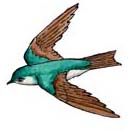

They spend the summer breeding from Alaska across Canada to Labrador, down to southern California across the U.S. to northern Georgia. They spend the winter in southern California, across to South Carolina, Florida, and the Gulf Coast south to Panama.
They are found in open areas near water and fields, in wooded swamps and shorelines.
They have long, pointed wings and a notched tail, a green back and a white belly.
They are strong fliers.
They catch insects in mid-flight.
They nest in an open cup of grass in a tree hole. They will use a nesting box. They find duck feathers to line their nests. Females lay 2 - 8 white eggs.
Kingdom: Animalia
Phylum: Chordata
Subphylum: Vertebrata
Class: Aves
Order: Passeriformes
Family: Hirundinidae
Genus: Tachycineta
Species: T. bicolor
When you research information you must cite the reference. Citing for websites is different from citing from books, magazines and periodicals. The style of citing shown here is from the MLA Style Citations (Modern Language Association).
When citing a WEBSITE the general format is as follows.
Author Last Name, First Name(s). "Title: Subtitle of Part of Web Page, if appropriate." Title: Subtitle: Section of Page if appropriate. Sponsoring/Publishing Agency, If Given. Additional significant descriptive information. Date of Electronic Publication or other Date, such as Last Updated. Day Month Year of access < URL >.
Amsel, Sheri. "Swallow (Tree)" Exploring Nature Educational Resource ©2005-2024. December 13, 2024
< http://exploringnature.org/db/view/124 >

